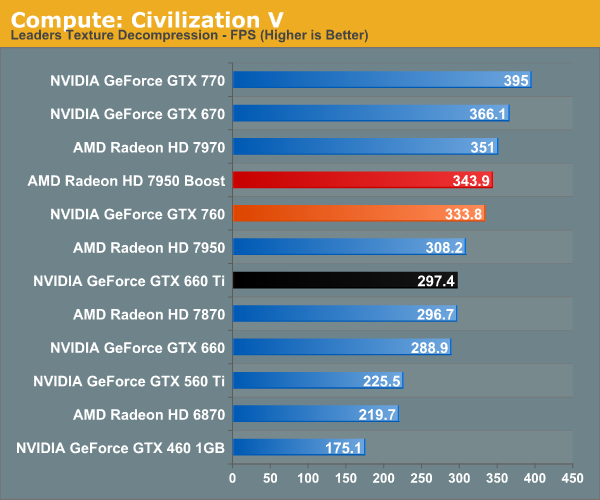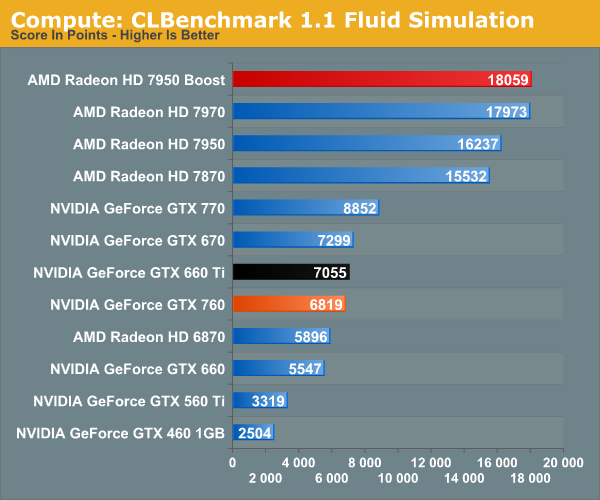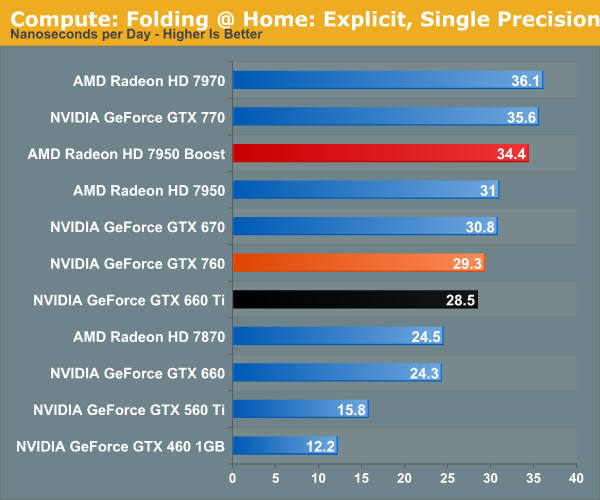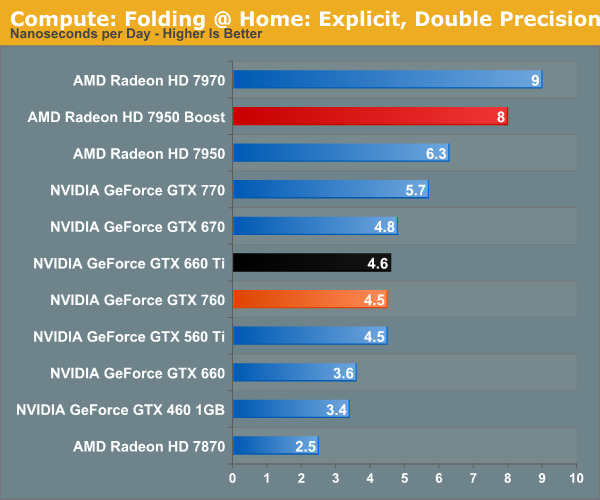NVIDIA GeForce GTX 760 Review: The New Enthusiast Kepler
by Ryan Smith on June 25, 2013 9:00 AM ESTCompute
Jumping into compute, we aren’t expecting too much here. Outside of DirectCompute GK104 is generally a poor compute GPU, and the loss of an SMX relative to the GTX 660 Ti isn’t doing the GTX 760 any favors here. By all appearances the GTX 760 is even more of a pure gaming card than the GTX 660 Ti was.
As always we'll start with our DirectCompute game example, Civilization V, which uses DirectCompute to decompress textures on the fly. Civ V includes a sub-benchmark that exclusively tests the speed of their texture decompression algorithm by repeatedly decompressing the textures required for one of the game’s leader scenes. While DirectCompute is used in many games, this is one of the only games with a benchmark that can isolate the use of DirectCompute and its resulting performance.

Civilization V once more validates that NVIDIA’s DirectCompute performance is generally up to snuff in this case. The fact that the GTX 760 is ahead of the GTX 660 Ti by any degree took us by surprise at first, but we’re likely looking at a scenario where the wider memory bus and/or larger L2 cache of GTX 760 offset some of the general compute gap.
Our next benchmark is LuxMark2.0, the official benchmark of SmallLuxGPU 2.0. SmallLuxGPU is an OpenCL accelerated ray tracer that is part of the larger LuxRender suite. Ray tracing has become a stronghold for GPUs in recent years as ray tracing maps well to GPU pipelines, allowing artists to render scenes much more quickly than with CPUs alone.

Luxmark is entirely about compute performance, and as a result this is an exceptionally poor showing for the GTX 760, with the GTX 660 Ti having no trouble besting it.
Our 3rd benchmark set comes from CLBenchmark 1.1. CLBenchmark contains a number of subtests; we’re focusing on the most practical of them, the computer vision test and the fluid simulation test. The former being a useful proxy for computer imaging tasks where systems are required to parse images and identify features (e.g. humans), while fluid simulations are common in professional graphics work and games alike.


Breaking down our CLBenchmark results, the computer vision test has frequently favored raw clockspeed over total shader throughput, which gives the GTX 760 an interesting advantage here. It’s capable of easily leaving the GTX 660 Ti in the dust and even edge out the GTX 670. Of course this is still less than 2/3rds the performance of even the slowest AMD GCN card, reflecting AMD’s superior computer performance.
The fluid simulation is especially brutal in that regard. Once again shifting back to an almost complete reliance on shader throughput, GTX 760 slightly trails GTX 660 Ti, never mind the nearly three-fold difference between it and the 7950B.
Moving on, our 4th compute benchmark is FAHBench, the official Folding @ Home benchmark. Folding @ Home is the popular Stanford-backed research and distributed computing initiative that has work distributed to millions of volunteer computers over the internet, each of which is responsible for a tiny slice of a protein folding simulation. FAHBench can test both single precision and double precision floating point performance, with single precision being the most useful metric for most consumer cards due to their low double precision performance. Each precision has two modes, explicit and implicit, the difference being whether water atoms are included in the simulation, which adds quite a bit of work and overhead. This is another OpenCL test, as Folding @ Home has moved exclusively to OpenCL this year with FAHCore 17.


Unlike some of our other compute benchmarks, the GTX 760 doesn’t fare too poorly here when it comes to single precision. However it’s still notably behind the 7950B in this case. And with double precision it’s no contest.
Wrapping things up, our final compute benchmark is an in-house project developed by our very own Dr. Ian Cutress. SystemCompute is our first C++ AMP benchmark, utilizing Microsoft’s simple C++ extensions to allow the easy use of GPU computing in C++ programs. SystemCompute in turn is a collection of benchmarks for several different fundamental compute algorithms, as described in this previous article, with the final score represented in points. DirectCompute is the compute backend for C++ AMP on Windows, so this forms our other DirectCompute test.

As another compute throughput bound benchmark, the GTX 760 is essentially tied with the GTX 660 Ti. This benchmark is somewhat memory bandwidth sensitive, which is why the GTX 760 doesn’t outright lose to the GTX 660 Ti here.










110 Comments
View All Comments
YukaKun - Tuesday, June 25, 2013 - link
And where's my beloved GTX670?! Are you guys hiding something here that nVidia doesn't want me to see?No, but really; I know it's not it's direct replacement, but I'd really like to see the numbers how they stack up.
Cheers!
Ryan Smith - Tuesday, June 25, 2013 - link
The GTX 670 is in all of our charts. All of this data is also on Bench.YukaKun - Tuesday, June 25, 2013 - link
Yeah, just realized it is... I wonder why I didn't see it, lol.Selective reading at its finest indeed.
Thanks Ryan!
HisDivineOrder - Tuesday, June 25, 2013 - link
AMD is now saying the Never Settle Reloaded bundle is running out at retailers. That means, you should be mentioning that it isn't going to last much longer and doesn't really factor into the value of the 7950/7950B unless they decide to renew it.I suspect though they'll do a price drop soon.
DanNeely - Tuesday, June 25, 2013 - link
I'd expect them to create a new bundle instead.kallogan - Tuesday, June 25, 2013 - link
Too big, barely better than 660 ti at higher power consumption. What's the point ?MrSpadge - Tuesday, June 25, 2013 - link
Too big: there will loads of custom coolers, just like on the current cards. Shorter ones as well.barely better than 660 ti at higher power consumption: the additional performance is approximately proportional to the added power draw, so efficiency hardly suffers. Of course I'll stick with my OC'ed 660Ti, but this newcomer is just more balanced for everything but the most pure compute tasks.
What's the point: cheaper for nVidia to produce (one SMX less) and sold cheaper. It's a win-win.
jimwatkins - Tuesday, June 25, 2013 - link
I suppose this is of little interest to most readers, but since your doing computer performance, how about a bitcoin GH performance chart. Video cards are actually of waning value in the bitcoin arms race but it's an interesting aspect of compute performance nonetheless and the high end AMD cards certainly still produce value.dcianf - Tuesday, June 25, 2013 - link
I'm excited to see them maintain compatibility with my 660Ti/670 full card waterblock. PLEASE LET THIS BE A NEW STANDARD!JimmiG - Tuesday, June 25, 2013 - link
Well it's hotter, more power hungry and louder than the GTX 670 while still being slower, which is kind of disappointing for something that's supposed to be an evolution of the GTX 600 series. Still, it does feel like "GTX 660 Done Right" in some ways, as that card was always too slow, forcing people to pay $400 for the GTX 670.It's sad that prices have been creeping up so much without people noticing. $499 used to be the "ultra-enthusiast" segment, and $199 would buy you a very decent card. In 2012 and early 2013, $400 was the "mid-range" and $999 the "ultra high-end". GTX 760 brings the mid-range back to $250 again, at least until the GTX 860 come out at $499...